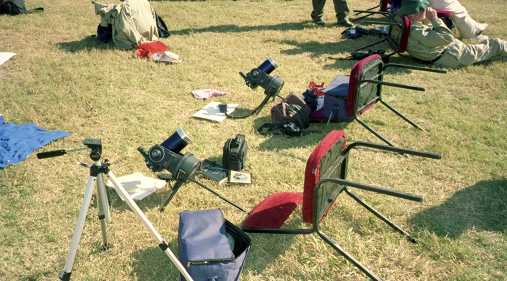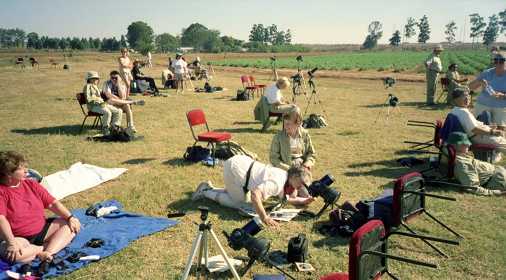USER OBSERVATIONS
Last updated: 9 July 2001
USER OBSERVATIONS |
Subject: ETX-90 a great eclipse field instrument Sent: Monday, July 2, 2001 16:34:25 From: bernie.j.verreau@intel.com (Verreau, Bernie J) I just returned from a trip to Zambia to observe the 6/21 solar eclipse. It was a successful effort, due in part to the performance and versatility of the ETX-90. My sister and I and another member of our party chose the ETX for its size and versatility. We brought our scopes for visual use only. The other person wanted to do prime focus photography of the eclipse. We shared the same problems and solutions, however. Here are some of the things that worked well: * The soft travel bags provided adequate protection through many airplane, coach and hotel transfers [hand carried only]. No equipment was lost or damaged along the way. * The size and weight factor was critical because of baggage limits. Some in the group had to leave larger scopes behind in storage because of charter plane restrictions. * Autostar made navigation around unfamiliar Southern Hemisphere skies a little easier. * A 100x view of Mars at opposition was great. It was almost at the zenith, of course. * AA batteries are easy to find in even the most remote outpost. * The standard 26mm Meade eyepiece produces a good sized field of view for observing the solar disk in its entirety during both the partial and total phases. Thousand Oaks ETX-90 solar filters were the perfect complement. We had plenty of group members and local guests queued up for a look at sunspots and the encroaching shadow throughout the eclipse. * The 3:16 totality was outstanding in the ETX-90! The chromosphere, inner corona and prominences were visible like I've never seen them before [this was my 17th total eclipse]. Everyone who shared the view felt it made the moment even more special. Some of the difficulties: * None of us could get Alt-Az tracking to work for the Southern Hemisphere. We tried lining up on true South, true North, reversing the home position - nothing. GoTo functions were seemingly random and tracking was worse with the drive on than off. We decided it must be a bug in the controller software. But then how do they sell these things south of the equator? * Luckily, we all had tabletop polar mounts. These work well at temperate latitudes, but were not designed for use inside 22d. Lusaka, our eclipse site, is at a latitude of about 19d. The solution was simple. We propped up the polar leg a bit, then weighed it down with an overturned chair. Worked great as long as no one bumped the chair. Using the tabletop mount at ground level isn't that bad. It's easier to observe from a prone position than a crouch. (Just watch out for the giant ants. :) * Daytime alignment in an unfamiliar site is a challange. A magnetic compass bearing and successive manual corrections proved adequate. By first contact were were holding the sun in the field for an hour or more. * I chose not to attempt photography because of my lack of preparation, but I really wish I'd been abe to capture a rose colored tierra-shaped detached prominence on film. I haven't been able to find a photo of it anywhere. Maybe next time. Clear skies! Bernie Verreau, Redwood City, CA
Subject: RE: ETX-90 a great eclipse field instrument Sent: Friday, July 6, 2001 16:43:33 From: bernie.j.verreau@intel.com (Verreau, Bernie J) Here are a couple pictures of the ETX's from the eclipse site. Bernie Verreau, Redwood City, CA


Return to the top of this page.
Go back to the User Observations page.
Go back to my ETX Home Page.